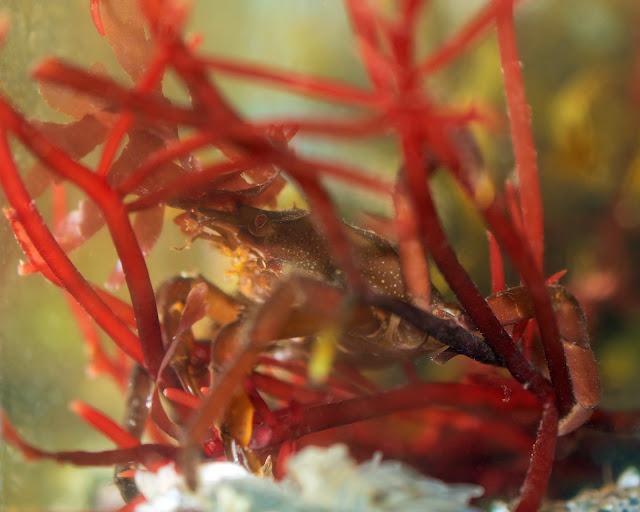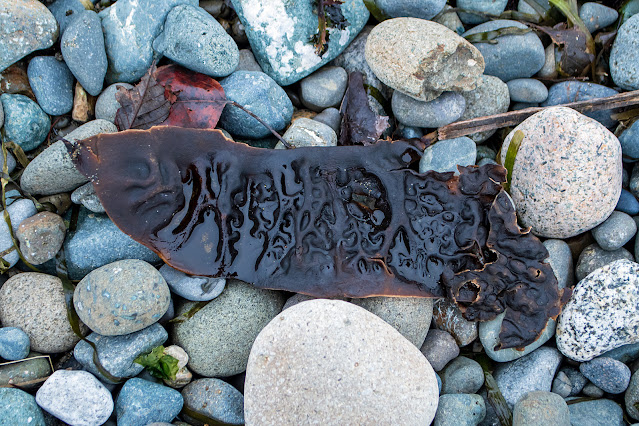Miracle Beach is a busy summer beach. It's a wide, sandy, clean beach at low tide, in season sprinkled with happy kids, sand sculptors, and sleepy sunbathers. I went down in mid-winter, at high tide. There was no sand. All along the shore, up against the wet logs (it had been raining), were mounds of shredded algae.
On other beaches, winter high tides bring in tangles of long bull kelp and knots of eelgrass, ripped up by the roots, maybe some rockweed, and an occasional blade of Turkish towel. Here on the Miracle Beach shore, most of the algae were brown and red. A variety of kelps, but not one piece of bull kelp along the whole length of the beach. Many red algae; blades and threads and delicate feathery branches. Everywhere there was Turkish towel, new and old, from deep wine red (fresh) to magenta, to pink, then, sun-bleached, to pure white.
 |
| At the north end of the beach, more sea lettuce intermingled with the reds and browns. The gull is carrying a piece of dark brown seaweed. |
Besides the sugarwrack here, there is brown: a smooth-bladed kelp, a blade of eyelet silk, a stipe of something or other. Red: a handful of red spaghetti, a small branch of sea lace, a blade of something pink, and a fragment of Turkish towel. Green: the sea lettuce, and eelgrass.
 |
| A fragment of a winged kelp. With a few leaves of California rose, or something similar, sea lettuce, eelgrass, Turkish towel, and a smooth red blade, maybe iridescent seaweed. |
 |
| A very bleached blade of Turkish towel, showing the knobby papillae. |
I brought home a small blade of Turkish towel, a clump of a small rockweed, and a handful of red spaghetti,
Gracilaria sp., all of which I added to the aquarium. The kelp crab loved the red spaghetti:
 |
| It's good camouflage, almost matching his long legs. |
 |
| No hiding place for a little hermit. |
~~~~~~~~~~~~~~~~~~~~~~~
La playa "Milagro", Miracle Beach, es una playa excelente para pasear un rato en el verano. Amplia, arenosa, limpia; siempre que la marea está baj, la playa está llena de niños jugando, escultores de figuras de arena, y gente soñolenta, tomando el sol. Pero yo fui a medio invierno, con la marea alta. No había arena. A todo lo largo de la playa, pilas y montones de algas marinas, rotas en pedacitos, cubrían el espacio entre el agua y los troncos caídos.
En otras playas, las altas mareas depositan nudos de hierba marina Zostera, y del kelp gigante, el de los tallos de muchos metros de largo, tal vez un poco del alga Fucus, y de vez en cuando un pedazo de toalla Turka. Aquí en la costa de Miracle Beach, casi todas las algas eran algas cafés o rojas. Había una gran variedad de alga "kelp", pero en toda la playa no vi ni un tallo del kelp gigante. De las algas rojas, había muchas diferentes, especialmente la toalla Turka por dondequiera, en todos sus colores, desde el rojo oscuro de la planta nueva, a magenta, color de rosa, y blanqueado hasta un blanco puro.
Las fotos; una gaviota con un pedazo de alga. Al extremo norte de la playa.
Una hoja de kelp "azucarada", con una variedad de pedacitos de otras algas.
Un trozo de kelp "alada".
Una lámina de lo que llaman ojete rojo. Es rojo cuando es nuevo, pero se vuelve amarillo con el tiempo. Siempre tiene esos agujeros.
Un pedazo blanqueado de toalla Turka, mostrando sus papilas.
Me traje a casa para el acuario, una rama de kelp azucarada, una plantita de Fucus, y un manojo de espagueti rojo. Al cangrejo kelp, le encantó este último: le sirve muy bien de camuflaje. Al ermitaño, no, pero como le gusta treparse a todo ...



























































